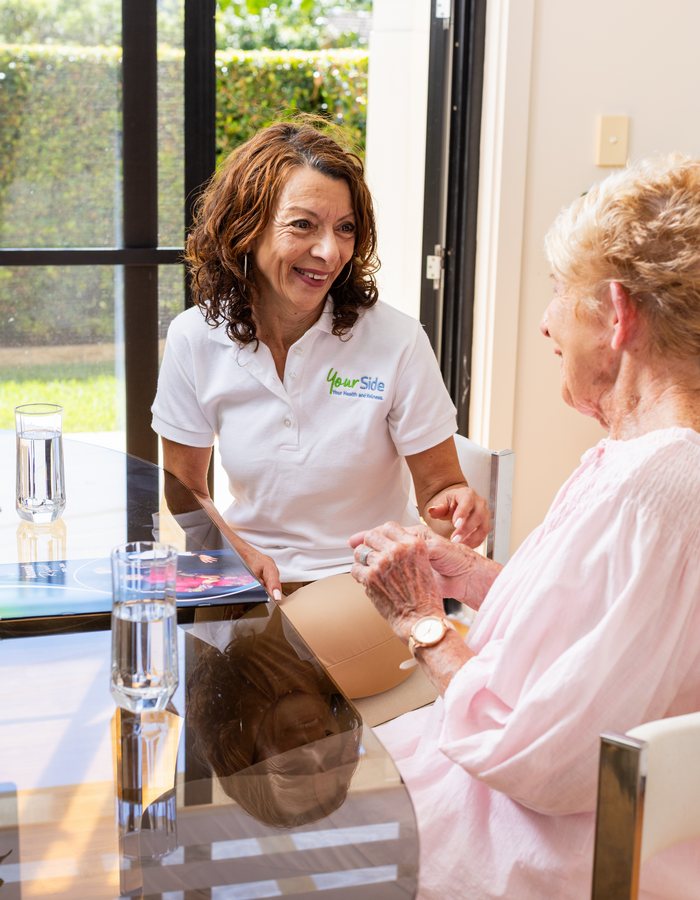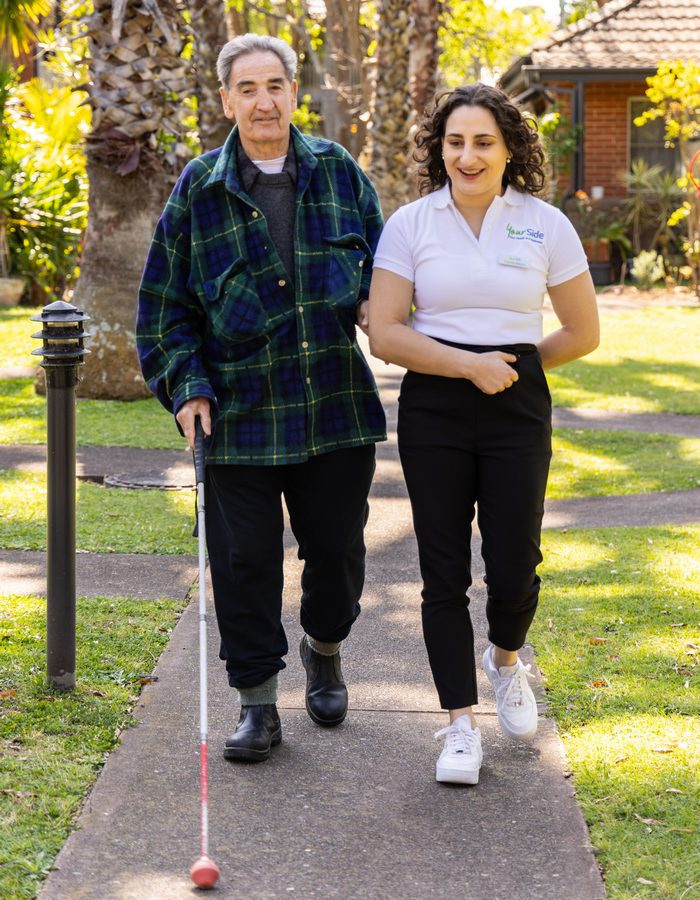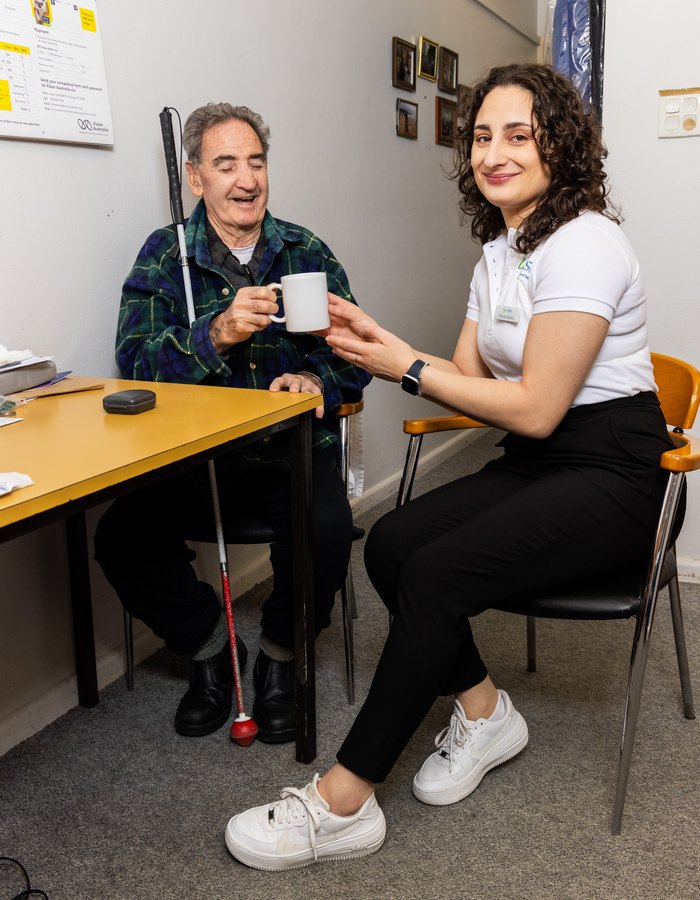This website uses cookies to improve your experience. Our Privacy Policy
Support at Home – what you need to know
Are you just starting to look into aged care? Support at Home is the new system for receiving funding and aged care services at home. You can request a call from one of our Aged Care Support Specialists to advise you on how to access support. Call us on 1300 134 332 or click the button below to fill out the form and someone will contact you:
Download a free Support at Home information booklet
Your Side have a comprehensive booklet with clear, simple language that you can download to read or print.
What is Support at Home?
Support at Home is the name of the new program from which you will access funding for aged care services at home from November 2025. This replaces Home Care Packages and the Short-Term Restorative Care Programme.
Strengthened Aged Care Quality Standards
The Aged Care Quality and Safety Commission (ACQSC) is the national regulator of funded aged care services. They are responsible for registering providers to deliver aged care services and monitoring and assessing providers’ compliance with the Code of Conduct for Aged Care, the Aged Care Quality Standards and other obligations.
The strengthened Quality Standards require providers of funded aged care services to ensure individuals receive care that meets their needs, goals and preferences and optimises their quality of life, reablement and maintenance of function.
Under Support at Home, individuals need a registered aged care provider to administer their aged care funding and deliver their services. Registration is the regulatory means for the Department of Health and Aged Care to ensure compliance to the Code of Conduct and monitor organisations in the aged care sector for the safety of the older people receiving services.
What is different about Support at Home?
With Home Care Packages, the amount of funding you received was related to the level of package you were deemed to need in your initial assessment. This determined the annual budget you were assigned, and your Care Consultant could help you decide what services and solutions to use it for in line with your Support Plan.
Under Support at Home you will be assessed for one of 11 new funding classifications. This includes eight ongoing classifications, and three short term classifications for home modifications, the restorative care pathway and end-of-life care pathway.

Regardless of the classification you are assigned, funded aged care services are grouped into three categories: Clinical Supports, Independence and Everyday living.
All participants must pay contributions for services in the Independence and Everyday living categories. Your contribution rates are determined by your pension status and a means-test and are set as a percentage of the price of each service. Participants will pay the amount set by their percentage contribution rate, and the government will pay the remainder of the price as a subsidy to registered aged care provider.
| CLINICAL SUPPORTS No contribution |
||
|---|---|---|
| Includes service types | Type of participant | Contribution range |
| • Care Management • Restorative Care Management • Allied Health + other Therapies • Nursing Care | All | No participant contribution required. Government covers all costs. |
| INDEPENDENCE Moderate contribution |
||
| Includes service types | Type of participant | Contribution range |
| • Personal Care • Social Support, Community Engagement and transport • Therapeutic Services for Independent Living • Respite care | Full pensioner | 5% |
| Part pensioner and Commonwealth Seniors Card eligible | Between 5% - 50% depending on income and assets | |
| Self-funded retiree | 50% | |
| EVERYDAY LIVING Higher contribution |
||
| Includes service types | Type of participant | Contribution range |
| • Meals • Domestic Assistance • Home Maintenance and repairs | Full pensioner | 17.5% |
| Part pensioner and Commonwealth Seniors Card eligible | Between 17.5%- 80% depending on income and assets | |
| Self-funded retiree | 80% | |

1. The first step to apply for Support at Home or any aged care funding, is to register with My Aged Care. This takes place over a phone interview where My Aged Care employee screen you for urgency of where you will be put in the National Priority System. They will give you a unique My Aged Care number (AC number) which you will be asked for to access information on your aged care funding application going forward. If you would like help dealing with the forms and processes, you can name a Support Person as your representative. Your Side has Aged Care Support Specialists who can help you apply and check the progress of your application and advise you.
Call My Aged Care on 1800 200 422
2. Once you are registered with My Aged Care, an aged care assessor will make an appointment to come to your home and assess your eligibility for residential and in-home aged care services with Support at Home using a needs-based Integrated Assessment Tool (IAT). The assessor uses the IAT to consider an older person’s strengths, capabilities and difficulties in the areas of:
- Family community engagement and support
- Carer responsibilities and sustainability of their caring
- Level of function
- Physical and personal health
- Home and Personal safety
- Goals, motivations and preferences
- Support considerations
- Level of complexity and risk of vulnerability
- Cognitive capacity and psychosocial circumstances
It should take around 1.5 – 2 hours and you can prepare by having the following information ready:
- Your Medicare card and one other form of ID proof – such as DVA card, driver’s license, healthcare card, or passport
- A copy of any referrals from your doctor
- Contact details for your GP, specialists or other health professionals
- Information on any current support you receive
- Any questions you have about aged care services
Using this tool and these criteria, the My Aged Care assessor will determine your level of priority as either urgent, high, medium or standard.
3. At the home visit, the assessor will develop a personalised Support Plan with your input to outline the care and services you will need.
The plan should summarise the findings of your aged care assessment and include recommendations for services and supports, plus guidance on how the services may be delivered.
4. After this visit, My Aged Care will send you a letter with their Notice of Decision. This is to let you know what classification you have been assigned, how much funding you will receive and what services you can use it for. It will also list any short-term supports you have been approved for.
You will then need to source a registered aged care provider to manage your funding and organise your services. You can choose which provider you want to engage. My Aged Care have an online tool to help you Compare Providers. Your Side is a reliable, registered aged care provider of more than 30 years’ experience.
5. Once you have selected your provider, a Care Partner will collaborate with you to develop a Care Plan. In line with your Support Plan and your funding budget, it outlines what services will be delivered and how. The Care Partner will schedule your services and issue statements on your budget’s use. They will review your needs and can request a re-assessment for a change of classification if needed.

The funding works differently than it did with a Home Care Package. For Support at Home, participants are assigned a quarterly budget that aligns to their funding classification. There are eight ongoing classifications, and three short term classifications for home modifications, the restorative care pathway and end-of-life care pathway.
| 8 Ongoing Classifications | Restorative Care Pathway | End of Life Pathway | Assistive Technology & Home Modifications Scheme |
|---|---|---|---|
| range $11,000 - $78,000 | around $6,000 | around $25,000 | up to $15,000 |

There are three additional funding streams for short-term services through the classifications:
- Assistive Technology and Home Modifications (AT-HM) Scheme
- Restorative Care Pathway
- End-of-Life Pathway
Under the Assistive Technology and Home Modifications (AT-HM) Scheme there are three tiers of funding which give you up to these amounts:
Low – $500
Medium – $2,000
High – $15,000
You have 12 months to spend the allocation for your home modifications or assistive technology.
For Restorative Care there is up to $6,000 funding available for a 12 week period. This can be increased to $12,000 under application*
People who have been diagnosed with three months or less to live, who wish to remain at home, can access End of Life Care funding which provides $25,000 per person to increase their services over a 12 week period. There is no cap on the amount of care management that can be claimed under the End-of-Life Pathway.

The table below shows how much funding is available within the eight different funding classifications for ongoing services.
| HCP Level Equivalent | Classification | Quarterly Budget | Annual Amount |
|---|---|---|---|
| 1 | 1 | $2,674.18 | $10,697.72 |
| 2 | $3,995.42 | $15,981.68 | |
| 2 | 3 | $5,479.94 | $21,919.77 |
| 4 | $7,386.33 | $29,545.33 | |
| 5 | $9,883.76 | $39,535.04 | |
| 3 | 6 | $11,989.35 | $47,957.41 |
| 7 | $14,530.53 | $58,122.13 | |
| 4 | 8 | $19,427.25 | $77,709.00 |
Participants will work with their provider to choose how to spend their budget across some or all of the services they have been approved to receive.

There are also funding supplements for:
- Oxygen – for people with a specified medical need for the continual administration of oxygen.
- Enteral feeding- for people with a specified medical need for enteral feeding.
- Veterans -for veterans with a mental health condition accepted by the Department of Veterans’ Affairs (DVA) as related to their service.
Each of these supplements can be applied for through Services Australia and the funding is paid into the client’s budget to be managed by their provider. The dementia and cognition supplement will also continue to be available for Home Care Package clients who were receiving it as of 30 June 2025. The Care Partners at Your Side can assist you with this.

Under Support at Home, you must pay contributions for services you receive in the Independence and Everyday living categories. The Age Pension means test will be used to determine the means tested percentage contribution, and Commonwealth Seniors Health Card holders will pay lower contributions than other self-funded retirees.
The government will cover all costs for clinical support services, such as care management, nursing and physiotherapy.
You will be required to make a moderate contribution for independence services (such as personal care), and products and equipment under the AT HM Scheme. The contributions are set between 5%- 50% of the hourly service rates depending on your pension status and income and assets.
The contribution rates for everyday living services (such as domestic help and gardening) are higher because the government does not typically fund these services. These will range between 17.5%- 80% of the hourly service rate depending on your pension status and income and assets.

Care Management is the service of an experienced professional who manages the delivery of the services and solutions identified for your needs in your Support Plan. The professional, called a Care Partner, has the knowledge and skills to monitor your health and condition and recommend any further supports you can use your aged care funding for. Support at Home participants, who receive ongoing services, have 10% deducted from their quarterly budget for care management. This funding will be held by Services Australia for all clients of a Care Partner and made available to draw down on.

Under Support at Home, if you don’t spend your budget each quarter, you can carry over unspent funds into the next quarter. The carryover amount is capped and will be up to the higher value of either a capped amount of $1,000, or 10% of your quarterly budget.
If you are a Home Care Packages client with unspent funds these will be held by Services Australia for you and can be used to top up your quarterly budget and pay for assistive technology and/or home modifications.






